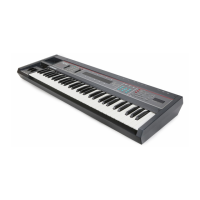SQ-80 — Musician's Manual
Pressure is the more common of the two types. Most MIDI instruments which currently implemen
Pressure send and receive only Channel Pressure. If you are playing or sequencing such an instrument.
from the SQ-80, you should set the SQ-80 to send Channel Pressure.
• KEY PRESSURE, sometimes referred to as Polyphonic Pressure or Poly Pressure, is a
more sophisticated and expressive type of Pressure. Key Pressure affects each key
independently. If, for example, you play a three-note chord, pressing down harder on any of the
three notes of the chord will modulate only that note. The other two notes will remain unaffected.
There is a control on the MIDI Page (PRESS=
—
) which determines which type of Pressure the SQ-80
ill generate. This same control can be used to turn off Pressure entirely, which is particularly useful
hen sequencing, since Pressure eats up a lot of Sequencer memory and should not be enabled when i
is not needed for a particular Track. See Pressure Control, p. 23, for more details.
Dynamic Voice Assignment Revealed
The SQ-80 can play up to eight different sounds at once — each of its eight voices can play any Program
at any time, no matter what the other seven are up to. This is, for example, how the Sequencer is able
to play lots of different sounds at once. This is called Dynamic Voice Assignment. You can demonstrate
this concept for yourself:
> Select a Program, preferably one with infinite sustain, such as an organ or strings
− Play one note and hold it down
− While holding the note down, select a new Program
− Still holding down the original note, play a note with the new sound and hold it down
− > While holding down both notes, select a third Program and play a note with
it > You can keep this up until you run out of fingers or patience or both
Notice that when you selected new sounds, the old sounds kept right on playing. The SQ-80 doesn't shu
down all the voices when you select a new Program, nor does it force you to make arbitrary choices abou
how many voices will be assigned to play each sound. Each Sequencer Track, as well as the Straigh
Synthesizer section, has access to all eight voices at any g
ven time. That is what is meant by Dynamic
oice Assignment, and it's what makes the SQ-80 a truly Multi-timbral instrument.
The Disk Drive
The SQ-80's built-in Disk Drive can be used to store SQ-80 sounds and Sequences, as well as MIDI
information from other devices, using the SQ-80's System Exclusive Storage function. Each Double-
Sided 3.5" micro-floppy disk will hold:
• 40 Program Banks, plus
• 128 individual Programs. plus
• 10 Sequencer/Sys-Ex blocks of up to 64k bytes each.
The Disk Drive in the SQ-80 is a precision instrument, and it will give you years of reliable service if
cared for properly. Here are a few things to bear in mind when using the Disk Drive:
• Use only Double-Sided Double-Density (DSDD) 3.5" micro-floppy disks.
• Don't expose disks. or the drive, to temperature extremes or strong magnetic fields.
• Take care not to spill liquids or any other material into the drive.
• Don't subject the Disk Drive (or the SQ-80 itself) to excessive shock during handling.
• Never eject the disk while the drive is running (the drive light is on).
• Never put anything other than a disk into the Disk Drive.
ou will find a full discussion of the disk functions in the section Disk Storage. p. 155.
10 Section 1
First Thin
s Firs

